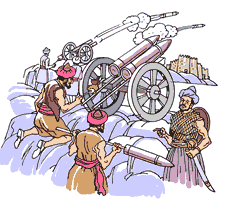
Dimdima
Online Children's Magazine from India

Dimdima
Online Children's Magazine from India

Space is that part of the universe that lies outside the earth’s atmosphere
A rocket is required to launch a spacecraft or for that matter, anything into space. Unlike airplanes, rockets can fly where there is no atmosphere. Multistage rockets can generate the speed required to break away from the earth’s gravitational pull.
Newton’s third law states that every action has an equal and opposite reaction. This law explains why the flow of air from a toy balloon propels it forwards. A rocket works in much the same way. A rocket is a tube that is open at one end and closed at the other. Fuel and oxygen are fed into the tube. The oxygen makes the fuel burn at a rapid rate. Exhaust gases from the burning fuel rush out from the nozzles at the rear of the rocket. This propels the rocket forward at high speed.
The first true rockets, as we know them today, were developed by the Chinese. In a battle with the Mongols, in 1232 A.D., they used rockets that were powered by gunpowder. In the next few centuries the use of rockets spread to other parts of Asia and to Europe. In India, Tipu Sultan successfully used war rockets in battles with English forces, in 1792 and 1799.The rockets he used were tipped with explosives.
Although none of the early rockets were used for human transport, an old Chinese legend shows that people were aware of this possibility.
According to the legend, a Chinese official named Wan Hu put together a rocket – powered flying chair. Attached to the chair were two large kites, and fixed to the kites were 47 rockets. Wan Hu seated himself in the chair and at a signal from him 47 assistants rushed to light the 47 fuses. There was a tremendous roar accompanied by billowing clouds of smoke. When the smoke cleared Wan Hu and his chair were gone. Nobody ever saw Wan Hu again. Most probably he was blown to bits.
EXPLORE MORE...
Get Help or Give Help.
- Do you have a Science Question?
- Post it here and get the answer.
- Some questions posted by others are not yet answered.
- View those questions and answer them.
Dimdima is the Sanskrit word for ‘drumbeat’. In olden days, victory in battle was heralded by the beat of drums or any important news to be conveyed to the people used to be accompanied with drumbeats.
Bharatiya Vidya Bhavan
K. M Munshi Marg,
Chowpatty, Mumbai - 400 007
email : editor@dimdima.com
Bharatiya Vidya Bhavan
505, Sane Guruji Marg,
Tardeo, Mumbai - 400 034
email : promo@dimdima.com
Dimdima.com, the Children's Website of Bharatiya Vidya Bhavan launched in 2000 and came out with a Printed version of Dimdima Magazine in 2004. At present the Printed Version have more than 35,000 subscribers from India and Abroad.